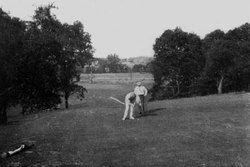George C. Thomas Junior
George Clifford Thomas Jr. (born October 3, 1873 in Philadelphia , † 1932 ) in was an American golf architect . He is considered one of the main representatives of the golden age of golf architecture and was one of the few significant amateurs in this field alongside Charles Blair Macdonald .
life and work
Born into a wealthy banking family, George C. Thomas Jr. grew up in Philadelphia and enjoyed a classic, middle-class upbringing. Nevertheless, after a year at the University of Pennsylvania, he dropped out of his studies and hired on Wall Street at Drexel, where his father held a management position. From 1900 he began to grow roses and English Setters with some success . He often spent his free time in Massachusetts , where he played on courses such as the Myopia Hunt Club and the Essex Golf Club.
Probably because of his engaging nature and his social position, he finally got the opportunity to create a 9-hole golf course for a friend in Marion . Soon after, a group of investors called on the Thomas family to want to build an 18-hole golf course on part of their property. The family agreed on the condition that George Jr. could design the square. In 1908, the Whitemarsh Valley Golf Club opened and George Thomas established himself in the inner circle of Philadelphia's golfing scene alongside AW Tillinghast , William Flynn , Hugh Wilson and George Crump.
As a result, he gained a lot of experience as a member of the court committee in various clubs. Among other things, he accompanied the construction of two Donald Ross courses and Tillinghast's expansion of the Philadelphia Cricket Club. He also followed Wilson's work in Merion up close and was a founding member of George Crump's Pine Valley project. With the same zeal he drove forward his rose cultivation and published a book about it in 1916. After an interlude as a bomber pilot in the First World War , he moved to California in 1919, where he hoped for better conditions for his rose growing.
As one of the heirs to the family fortune, he was now financially independent. In the next ten years he designed, mostly with his assistant William "Billy" Bell, about 25 places, of which only a few have survived and these few have been more or less changed. These primarily include Riviera (1926), the North Course of the Los Angeles Country Club (1921, 1926), La Cumbre (1920), Griffith Park (36 holes, 1923), Ojai Valley (1925) and Bel-Air (1927) , and Fox Hills (1927, lost today).
Despite his relatively small portfolio, George C. Thomas is an important representative of the golden age, as he had outstanding skills in the field of strategic design and documented the underlying principles in his book (see literature). For example, the north course of the Los Angeles Country Club could be played in four different ways: the bandwidth ranged from a short, idiosyncratic par 69 to a long, difficult par 73 - only achieved by repositioning the flags and tee markings. Because of this extremely high variability, he did not have to undulate the greens quite as much as many of his colleagues, he rather determined the strategy of a hole from the tee and fairway. With the help of cleverly placed bunkers, he opened - sometimes only seemingly - several alternative routes to the green and often rewarded the player who could control the trajectory of the ball (draw, fade).
literature
- George C. Thomas: Golf Course Architecture in America . Clocktower Press, Ann Arbor 1997. ISBN 1886947147
- Geoff Shackelford: The Captain: George C. Thomas Jr. and His Golf Architecture . Sleeping Bear Press, Chelsea 1996. ISBN 1886947287
- Geoffrey S. Cornish , Ronald E. Whitten: The Architects of Golf . HarperCollins, New York 1993. ISBN 0062700820
| personal data | |
|---|---|
| SURNAME | Thomas, George C. Junior |
| ALTERNATIVE NAMES | Thomas, George Clifford Jr. |
| BRIEF DESCRIPTION | American golf architect |
| DATE OF BIRTH | October 3, 1873 |
| PLACE OF BIRTH | Philadelphia |
| DATE OF DEATH | 1932 |
